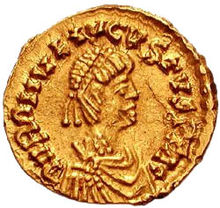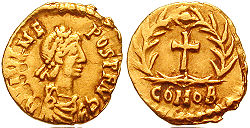
Romulus Augustulus
Background Information
SOS Children, an education charity, organised this selection. SOS Child sponsorship is cool!
| Augustus | |
|---|---|
| Emperor of the Western Roman Empire |
|
 Tremissis of Emperor Romulus Augustus |
|
| Reign | 31 October 475 – 4 September 476 |
| Full name | Flavius Momyllus Romulus Augustulus |
| Died | unknown, after 476, before 488 |
| Place of death | unknown, probably Castellum Lucullanum |
| Predecessor | Julius Nepos |
| Successor | Odoacer (as King of Italy) |
| Father | Orestes |
Romulus Augustus (born perhaps around 460 – died after 476, possibly alive around 500), is sometimes considered the last Western Roman Emperor (although by other accounts the last Western Roman Emperor was Julius Nepos, deeming Romulus' reign unconstitutional), reigning from 31 October 475 until 4 September 476. His deposition by Odoacer traditionally marks the end of the Western Roman Empire, the fall of ancient Rome, and the beginning of the Middle Ages in Western Europe.
He is also known by his nickname "Romulus Augustulus", though he ruled officially as Romulus Augustus. The Latin suffix -ulus is a diminutive; hence, Augustulus effectively means "Little Augustus".
The historical record contains few details of Romulus' life. He was installed as emperor by his father Orestes, the magister militum (master of soldiers) of the Roman army after deposing the previous emperor Julius Nepos. Romulus, little more than a child, acted as a figurehead for his father's rule. Reigning for only ten months, Romulus was then deposed by the Germanic chieftain Odoacer and sent to live in the Castellum Lucullanum in Campania; afterwards he disappears from the historical record.
Life
Romulus' father Orestes was a Roman citizen, originally from Pannonia, who had served as a secretary and diplomat for Attila the Hun and later rose through the ranks of the Roman army. The future emperor was named Romulus after his maternal grandfather, a nobleman from Poetovio in Noricum. Many historians have noted the coincidence that the last western emperor bore the names of both Romulus, the legendary founder and first king of Rome, and Augustus, its first emperor.

Orestes was appointed Magister militum by Julius Nepos in 475. Shortly after his appointment, Orestes launched a rebellion and captured Ravenna, the capital of the Western Roman Empire since 402, on 28 August 475. Nepos fled to Dalmatia, where his uncle had ruled a semi-autonomous state in the 460s. Orestes, however, refused to become emperor, "from some secret motive", according to historian Edward Gibbon. Instead, he installed his son on the throne on 31 October 475.
The empire Augustulus ruled was a shadow of its former self and had shrunk significantly over the previous 80 years. Imperial authority had retreated to the Italian borders and parts of southern Gaul: Italia and Gallia Narbonensis, respectively. The Eastern Roman Empire treated its western counterpart as a client state. The Eastern Emperor Leo, who died in 474, had appointed the western emperors Anthemius and Julius Nepos, and Constantinople never recognized the new government. Neither Zeno nor Basiliscus, the two generals fighting for the eastern throne at the time of Romulus' accession, accepted him as ruler.
As a proxy for his father, Romulus made no decisions and left no monuments, though coins bearing his name were minted in Rome, Milan, Ravenna, and Gaul. Several months after Orestes took power, a coalition of Heruli, Scirian and Turcilingi mercenaries demanded that he give them a third of the land in Italy. When Orestes refused, the tribes revolted under the leadership of the Scirian chieftain Odoacer. Orestes was captured near Piacenza on 28 August 476 and swiftly executed.
Odoacer advanced on Ravenna, capturing the city and the young emperor. Romulus was compelled to abdicate the throne on 4 September 476. This act has been cited as the end of the Western Roman Empire, although Romulus' deposition did not cause any significant disruption at the time. Rome had already lost its hegemony over the provinces, Germanics dominated the Roman army and Germanic generals like Odoacer had long been the real powers behind the throne. Italy would suffer far greater devastation in the next century when Emperor Justinian I re-conquered it.
After the abdication of Romulus, the Roman Senate, on behalf of Odoacer, sent representatives to the Eastern Roman Emperor Zeno, whom it asked to formally reunite the two halves of the Empire: "the west… no longer required an emperor of its own: one monarch sufficed for the world". He was also asked to make Odoacer a Patrician, and administrator of Italy in Zeno's name. Zeno pointed out that the Senate should rightfully have first requested that Julius Nepos take the throne once more, but he nonetheless agreed to their requests. Odoacer then ruled Italy in Zeno's name.
Later life
The ultimate fate of Romulus is a mystery. The Anonymus Valesianus wrote that Odoacer, "taking pity on his youth", spared Romulus' life and granted him an annual pension of 6,000 solidi before sending him to live with relatives in Campania. Jordanes and Marcellinus Comes say Odoacer exiled Romulus to Campania but do not mention any reward from the Germanic king.
The sources do agree that Romulus took up residence in the Lucullan Villa, an ancient castle originally built by Lucullus in Campania. From here, contemporary histories fall silent. In the History of the Decline and Fall of the Roman Empire, Edward Gibbon notes that the disciples of Saint Severinus of Noricum were invited by a "Neapolitan lady" to bring his body to the villa in 488 "in the place of Augustulus, who was probably no more." The villa was converted into a monastery before 500 to hold the saint's remains.
Cassiodorus, then a secretary to Theodoric the Great, wrote a letter to a "Romulus" in 507 confirming a pension. Thomas Hodgkin, a translator of Cassiodorus' works, wrote in 1886 that it was "surely possible" the Romulus in the letter was the same person as the last western emperor. The letter would match the description of Odoacer's coup in the Anonymus Valesianus, and Romulus could have been alive in the early sixth century. But Cassiodorus does not supply any details about his correspondent or the size and nature of his pension, and Jordanes, whose history of the period abridges an earlier work by Cassiodorus, makes no mention of a pension.
Last emperor
As Romulus was a usurper, Julius Nepos claimed to legally hold the title of emperor when Odoacer took power. However, few of Nepos's contemporaries were willing to support his cause after he ran away to Dalmatia. Some historians regard Julius Nepos, who ruled in Dalmatia until being murdered in 480, as the last lawful Western Roman Emperor.
Following Odoacer's coup, the Roman Senate sent a letter to Zeno stating that "the majesty of a sole monarch is sufficient to pervade and protect, at the same time, both the East and the West". While Zeno told the Senate that Nepos was their lawful sovereign, he did not press the point, and he accepted the imperial insignia brought to him by the senate.
In popular culture
- The 2007 film The Last Legion, and the novel on which it is based, includes a heavily fictionalized account of the reign and subsequent life of Romulus Augustus; escaping captivity with the aid of a small band of loyal Romans, he reaches Britain, where he takes a place in what will become Arthurian legend as Uther Pendragon, the father of King Arthur, and a previous wielder of Excalibur (here the sword of Julius Caesar).
- The Marvel Comics character known as Tyrannus has the "real name" of "Romulus Augustus", and originates in ancient Rome.
- The play Romulus the Great (1950), by Friedrich Dürrenmatt, an "Ungeschichtliche historische Komödie" (unhistorical historical comedy) about the reign of "Romulus Augustus" and the end of the Roman Empire in the West.


